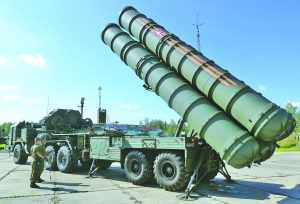 India has finally gone ahead with the well-calculated purchase of the S-400 missile defence system from Russia despite the frequently the repeated threat of sanctions by the US. The $5 billion deal was clinched during Russian President Vladimir Putin’s recent visit to New Delhi. By clinching the deal to acquire one of the most sophisticated surface-to-air defence missile systems, India has asserted that its decisions, taken in view of national interests, cannot be influenced by any power on earth.
India has finally gone ahead with the well-calculated purchase of the S-400 missile defence system from Russia despite the frequently the repeated threat of sanctions by the US. The $5 billion deal was clinched during Russian President Vladimir Putin’s recent visit to New Delhi. By clinching the deal to acquire one of the most sophisticated surface-to-air defence missile systems, India has asserted that its decisions, taken in view of national interests, cannot be influenced by any power on earth.
Having a range of 400 km (248 miles), the S-400 Trumf missile can identify and destroy 80 targets simultaneously. Since China had already purchased this latest missile shield, completely disregarding the US sanctions threat, India could not remain unmoved. In fact, New Delhi should have gone ahead to buy the new missile system much earlier than China, which acquired it in September this year. There is a limit to bothering about the US reaction while taking decisions to procure defence equipment from any source other than Washington.
The US got unnerved as India’s decision to acquire the Trumf missile defence system was announced ignoring Washington’s foreign policy moves aimed at using any available opportunity to punish Russia for its capture of Cremea from Ukraine and Moscow’s meddling in the 2016 US presidential elections.
When the US can go to any extent to safeguard its national interests, why should it object to India purchasing defence equipment from Russia or buying petroleum products like oil and gas from Iran? Did India show its displeasure when the US enacted a law — Countering America’s Adversaries Through Sanctions Act (CAATSA) — to punish any country or its business entity entering into deals with defence and intelligence sectors of Russia, Iran and North Korea, knowing it well that CAATSA might hit New Delhi’s interests considerably? Obviously, India displayed maturity by keeping quiet.
True, India’s relations with the US have scaled new heights during the past few years. India today can do nuclear trade with any country without any kind of international scrutiny after it signed the civilian nuclear deal with the US during the George Bush administration, which convinced the Nuclear Suppliers Group to allow a waiver in the case of India as it has been conducting itself as a responsible nuclear weapon power despite not having signed the Non-Proliferation Treaty (NPT). As a result, India purchased some nuclear reactors from the US to give a push to its nuclear power generation project.
Besides these, India purchased a number of expensive-130J and-17 military transport aircraft, P-8I long-range, multi-mission maritime patrol aircraft and AH-64 Apache multi-role combat helicopters between 2008 and 2016 from the US costing around $16 billion.
India also signed a deal with France in 2016 to buy Dassault-manufactured Rafale fighter aircraft for $10 billion. The Rafales, though mired in a controversy, will be supplied during 2019-21 — 18 will be imported and 108 will be manufactured in India.
Thus, India has shown that there is no reason why it will not take interest in any kind of offers, military or otherwise, from countries other than the US.
As Army Chief Gen Bipin Rawat told a questioner during his recent six-day Russia visit, “Yes, we do appreciate that there could be sanctions on us, but we follow an independent policy.”
If this was not enough to satisfy Russia, feeling uneasy because of the strengthening India-US relations, Gen Rawat specifically told the Russians again, “You can rest assured that while we may be associating with America in getting some technology, our foreign policy remains independent.”
Interestingly, the Army Chief was in Russia when Prime Minister Narendra Modi and President Putin signed the deal for the supply of S-400 missile defence systems to India. He pointed out to the Russians that India was prepared to procure more military hardware like Kamov helicopters from Russia, an old and trusted ally, to highlight the point that New Delhi values its time-tested relations with Moscow.
There is one major advantage in entering into defence technology-related deals with Russia. All weapon systems acquired from Moscow are manufactured under the Make in India policy arrangement. According to a well-known Russian defence expert, Konstantin Makienko, “Russia is the only country that has huge experience of licensed production of its military equipment in India. In fact, ever since the Soviet Union entered the Indian market in the 1960s, Moscow worked according to the Make In India principle.”
The Russian expert went on to explain the situation by stating, “Even the first projects of supplying MiG-21 second generation aircraft included a license transfer allowing their production in India. This practice continued with new MiG-23 and MiG-27 aircraft and reached its peak with the implementation of the Su-30MKI programme. Russia was also quite actively cooperating in other projects, such as in ship building in Indian shipyards as well as in producing T-72C and T-90C tanks for the Indian Army.”
India, the largest importer of Russian military hardware, gets its annual defence supplies worth $4 billion from Moscow. Since India is also the world’s biggest importer of defence products after Saudi Arabia, most countries manufacturing military equipment have been competing for fulfilling Indian demands by using different tactics.
Yet no country has so far succeeded in replacing Russia in the Indian defence market. In terms of their value, military equipment reaching India from the US every year is worth an annual $16 billion since 2008 — an average of $2 billion a year — which is just 50 per cent of that from Russia.
India also cannot afford to ignore Russia under the US pressure as China and Pakistan have been trying to take the help of Moscow to quip their armed forces with cutting-edge military technologies in view of the Russian products being cheaper than those produced in Europe or the US. Since Pakistan is finding it difficult to procure military supplies from the US owing to the growing deterioration in their relations, Islamabad has to look for other sources to meet the needs of its defence forces. As the Russian defence units also need markets for their sustenance, the situation suits both Moscow and Islamabad under the prevailing circumstances. Pakistan cannot depend only on China for all its military hardware requirement owing to strategic reasons despite Beijing being its all-weather friend.
India’s relations with Russia have a long and glorious history. Bothneed each other today too though there is a drastic change in the geopolitical and strategic matrix in the world. Keeping these factors in view, New Delhi will have to convince the Donald Trump administration to use the US President’s power for allowing a waiver in the case of India. Any US move to impose sanctions will create bitterness in the India-US relations, which may ultimately embolden China to continue with its expansionist policies in South Asia, East Asia and other sensitive regions. Nothing should be done to weaken India-US bonds as these are essential for maintaining the balance of power at least in the region where India is located.
letters@tehelka.com













